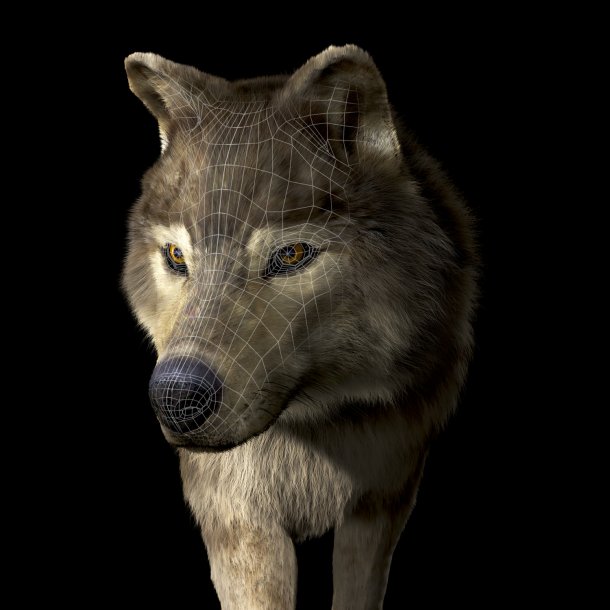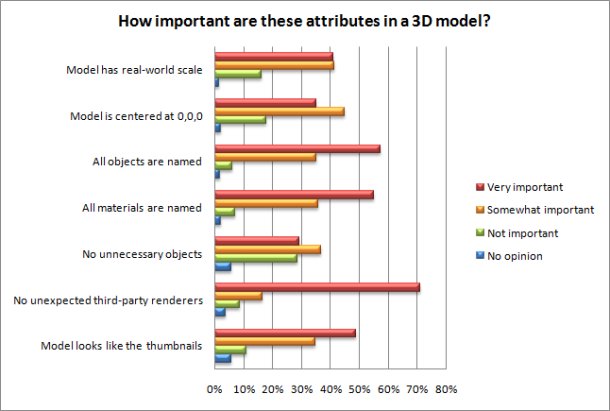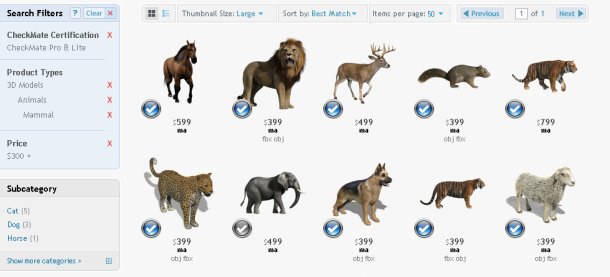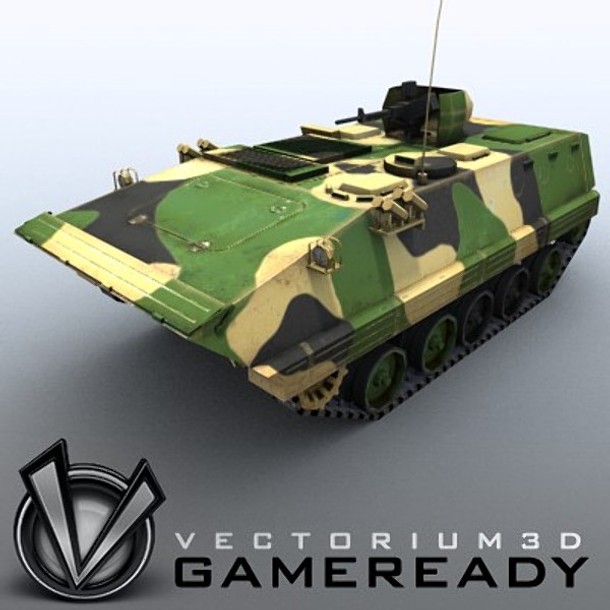TurboSquid: why we need quality control for models
 This week, TurboSquid launched its new CheckMate certification program. Over two years in development, the CheckMate scheme offers a guarantee that models carrying its logo meet basic quality standards: a first step towards stamping out the shoddily constructed or inaccurately described stock assets that plague many online marketplaces.
This week, TurboSquid launched its new CheckMate certification program. Over two years in development, the CheckMate scheme offers a guarantee that models carrying its logo meet basic quality standards: a first step towards stamping out the shoddily constructed or inaccurately described stock assets that plague many online marketplaces.
We caught up with Michele Bousquet, TurboSquid’s VP of marketing, to discuss what prompted the company to develop CheckMate, the survey of over 1,000 site users on which the standard is based, and whether tickmark standards like this can benefit the industry as a whole.
CG Channel: What prompted TurboSquid to introduce CheckMate?
Michele Bousquet: We’ve talked about the quality situation internally many times over the years – lots of people at TurboSquid come from 3D production backgrounds where they worked with in-house studio standards. Several of us felt very strongly that if we wanted to make stock 3D better, we were going to have to step up and put forth some definite standards of our own and reward or recognize artists who followed those standards.
About two years ago, having found no appropriate existing standard, we began developing CheckMate. With over 2 million members and more than 20,000 artists selling on the site, we already had a ready-made demographic of production artists available to survey.
As we settled on different points for the standard, we announced them on our blog, eventually forming a unified set of Best Practices that we would eventually announce as the CheckMate Certification program. This is something completely new: a stock 3D company setting 3D modeling standards.

One of the first wave of CheckMate-certified models, created by Italian artist Massimo Righi.
CGC: What benefits do you feel CheckMate will bring to your users?
MB: First, that the model will load and work as expected in any certified file format. The presentation guidelines, which include rendered preview images, wireframes, and full production information (poly count, type of mapping, and so on) mean customers know exactly what they are buying, and are able to make informed purchasing decisions without any guesswork.
Sellers will also benefit because CheckMate allows them to differentiate themselves. Customers will be able to use it as a search filter and view only those models that have been certified, enabling artists to stand out from the crowd. We are confident that we will see an increase in demand and sale of CheckMate models.

Part of TurboSquid’s user survey data that underpins the new CheckMate standard.
CGC: Let’s talk about the customer survey on which the standard is based. Did any of the results surprise you?
MB: Yes! The most surprising result was that customers would pay artists more for a model that had all the attributes they wanted. You can imagine how hard it is to get people to say they’ll pay more for something. But 66% said they’d pay 10% more, and a substantial number said they’d pay 25%, 50%, even 100% more.
This was the real turning point in our research. The only way a certification program was going to work was with artist co-operation, and we weren’t sure artists would agree that it would be worthwhile to go the extra mile. When that particular result came up on the screen, in an otherwise more-or-less routine meeting with [TurboSquid CEO] Matt Wisdom in 2009, we both suddenly realized that a certification program was within our reach. It was a very exciting moment: one that stayed with us through the next two years of work.
There were a few smaller surprises. For example, I had no idea that so many people were so passionate about intelligently named objects!
CGC: How did the standard evolve as you went through the consultation process?
MB: Some of the things customers wanted required an inordinate amount of effort from artists, to the point where the amount of work involved was out of proportion to the benefit. Whenever there was a lot of pushback from artists on these points during the beta period, we reviewed the standard and came up with a reasonable compromise on these points if we could.
Initially, we required all unwrapped UVs to be non-overlapping. Artists found this to be unnecessarily restrictive. When we reviewed the survey results, we found that customers felt especially strongly about this for people or animals. So we amended the specification to only require non-overlapping, unwrapped UVs on characters.
When it came to model topology, the spec originally read: “Quads and tris only, with at least 90% quads”. We set the ratio somewhat arbitrarily, based on our staff members’ production experience. During the beta period, we found that although the 90/10 ratio worked fine for most models, some models really needed more than 10% tris for efficient construction. So we relaxed the standard to make the 90/10 ratio as a guideline only.
The original CheckMate Pro spec also required wireframe turntables, but artists started to baulk at the extra work. We did a quick survey just on this point, and most customers who responded didn’t feel wireframe turntables were necessary to make a purchasing decision, so we dropped this requirement from the spec.
CGC: Most of the CheckMate standard seems like good common sense, but not everyone models in the same way. Can you really make ‘no n-gons’ a rigid rule, for example?
MB: That was one of the first standards we put on the list, and it was also one of the stickiest to get compliance on. All the personnel at TurboSquid who had worked as production artists had used this standard in professional environments, and we felt strongly about it from the get-go.
When we surveyed them, about half of our clients didn’t care, but the half that did were pretty adamant about it. When Pixar, Zynga and five other top customers tell you they don’t want models that contain n-gons, you know it’s the right decision.
But if you know you need to use only quads and tris right from the start, it’s not a burden at all. The same could be said for unwrapped UVs on characters. We expect that some artists will just use the standard going forward with new models, and won’t necessarily go back and fix up older models if it’s too much hassle.
CGC: CheckMate includes detailed standards for the way in which a model should be presented. Isn’t it up to an artist how they market their work?
MB: We found that in customer’s minds, presentation was intertwined with perceptions of quality. For example, in talking to customers, we found these equivalencies:
- No wireframe images = Artist is ashamed to show bad topology
- Text and borders on signature images = Cheap, cheesy
- Ugly rendered thumbnail = Bad model
- Lame description = Unprofessional artist
- No poly count = Too much mystery. Run away!
We felt it would be a terrible tragedy to go to all this trouble to have a model with high-quality topology, texturing, and so on, and then have a cheap-looking presentation. So we set standards for presentation that would match the quality of the models themselves. The presentation standards are really quite easy to meet, and make a huge difference in conveying model quality.
Other requirements are there simply to solve our most common support questions: for example, customers often can’t find the textures that go with a model, despite our best efforts to tell them where to find them. So we added to the specification that each certified file format must be zipped up with a full set of textures. It’s a bit of extra work for the artist (and a lot of extra storage space for us!) but it will make the stock 3D experience much smoother for a large number of customers, especially infrequent or first-time purchasers.

Users can choose to return only CheckMate Pro-compliant models in search results. Ensuring that the logo is prominently displayed on the site is intended to give artists participating in the program a competitive edge.
CGC: How long does it take for one of your inspectors to check out a model?
MB: For CM Pro, it takes 30-60 minutes to inspect a single model. We have automated tools that detect n-gons, overlapping faces, and so on, but after that, the inspector has to actually look at the model, open it to make sure it loads without errors, and check that it matches the thumbnails. A CM Lite inspection takes 15-30 minutes.
CGC: What percentage of models get approved first time?
MB: It’s very rare for an artist’s first submission to pass the first time. The first model usually goes back and forth between inspector and artist several times before it passes. But the second and subsequent models take a fraction of the time to pass. By the fifth or sixth submission, an artist will often pass on the first try.
CGC: Why is CheckMate only available to SquidGuild members? If you feel certification will raise sales, why not just charge a small fee to cover the cost of inspection?
MB: SquidGuild artists have given us a great starting point for our beta program. They are our most loyal members, and we were keen to reward that loyalty by initially offering them the opportunity.
We have a very large number of SquidGuild models on the site, and we’re going to focus on certifying those before we consider non-SquidGuild models.
CGC: CheckMate certification is only available for models above a minimum price ($149 for CheckMate Pro, $39 for CheckMate Lite). Won’t this restrict uptake?
MB: We settled on these minimums after a careful review of model value and pricing on our site. In the future, we intend to reduce the price minimums for less complex models, although we’re not sure if we’ll ever certify models in the $1-5 price range.

A model by Vectorium carrying the defunct Game-Ready certification. Is CheckMate more durable?
CGC: TurboSquid recently discontinued its Game-Ready Certified standard, which covered some of the same ground. Why do you think CheckMate will be more successful?
The use of Game-Ready as a search filter had pretty much dwindled to nothing because the standard we had set four or five years ago was out of date. If we had updated it, it might have revived, but as this was about the time we started to develop CheckMate, it just made sense to retire Game-Ready.
CheckMate is a much broader standard. You could say that the Game-Ready standard is a subset of CheckMate. We expect CheckMate to appeal to not just game developers, but artists in film, broadcast, media, advertising, architectural visualization and the military.
CGC: Would you consider working with other sites to turn CheckMate into a universal standard?
MB: The short answer is: “Yes, but not now.”
The CheckMate standard represents a significant investment for us, so we are understandably protective of it. The specification is publicly available in our Knowledge Base – an artist doesn’t even need to be a TurboSquid member to read them and use them in his/her own work. We believe that if all 3D artists followed the standards, the industry as a whole would be better off. But the CheckMate brand itself is reserved for TurboSquid.
In the future, we’re looking toward making CheckMate a universal standard, in the same way that Java went from Sun’s brainchild to widespread acceptance. But we need to iterate with artists and customers to develop the standard further before it’s ready for the entire world, and we don’t think it would be beneficial to manage such a process by a committee of competing businesses with different commercial interests.
CGC: Finally, some people feel that TurboSquid could have done more to vet the quality of models in its database, but didn’t because it’s beneficial to be able to say that a high number of assets are available. Would you dispute that?
MB: That’s an interesting comment. We stopped focusing on the numbers a long time ago – we don’t even put a running count of the total number of 3D models on our homepage any more. The real reason was the amount of work to vet the models and a lack of clarity about what that standard would be. But we’ve got a strong vision now about how to proceed.
The intention is that our entire catalog will eventually meet the CheckMate Lite standard. If all 220,000 of our models met two of the simplest Lite requirements, two wireframe images and complete product information, we would expect nothing less than a boom in stock 3D usage.
Read more about TurboSquid’s CheckMate certification programme
Read the Knowledge Base guidelines on which the standards are based
